
by Contributed | Dec 13, 2023 | Technology
This article is contributed. See the original author and article here.
We are excited to announce limited General Availability of Azure Defender for new Microsoft Azure Database for PostgreSQL – Flexible Server instances. This is another add-on, which, if deployed, provides another important security barrier to your Azure PostgreSQL server in addition to existing security features, we blogged about earlier.

In the following article, we will discuss how adding Azure Defender for OSS databases with your PostgreSQL Flexible server will help you secure your applications from hacking attacks.
Protection against brute force attacks
A brute force attack uses trial-and-error to guess login info, encryption keys, or find a hidden web page. Hackers work through all possible combinations hoping to guess correctly.
These attacks are done by ‘brute force’ meaning they use excessive forceful attempts to try and ‘force’ their way into your private account(s).
The “brute-force” terminology is derived from the tactic of using constant attempts or excessive “force” until the threat actor arrives at the desired result—entry into a system with the right credentials. Despite this being one of the oldest hacking methodologies, according to Verizon’s 2020 Data Breach Investigations Report, hacking, which includes brute forcing passwords, remains the primary attack vector. Over 80% of breaches caused by hacking involve brute force or the use of lost or stolen credentials.
 PostgreSQL brute force attack example
PostgreSQL brute force attack example
When Microsoft Defender detects a brute force attack, it triggers an alert to bring you awareness that a brute force attack took place. It also can separate simple brute force attack from brute force attack on a valid user or a successful brute force attack.
Detecting anomalous database access patterns
Databases may store extremely sensitive business information, making them a major target for attackers. Therefore, securing their data from damage or leakage is a critical issue. To manage this, enterprises typically implement several layers of protection between users and data, working at the network, host, and database levels. The data protection at database level includes the access control models to limit the permissions to of legitimate users to read, write data and encryption at times. These security models are sometimes insufficient to prevent misuse, especially insider abuse by legitimate users. When Microsoft Defender detects anomalous pattern, it fires an alert to make you aware of such activity as well.
Enabling Microsoft Defender with PostgreSQL Flexible Server
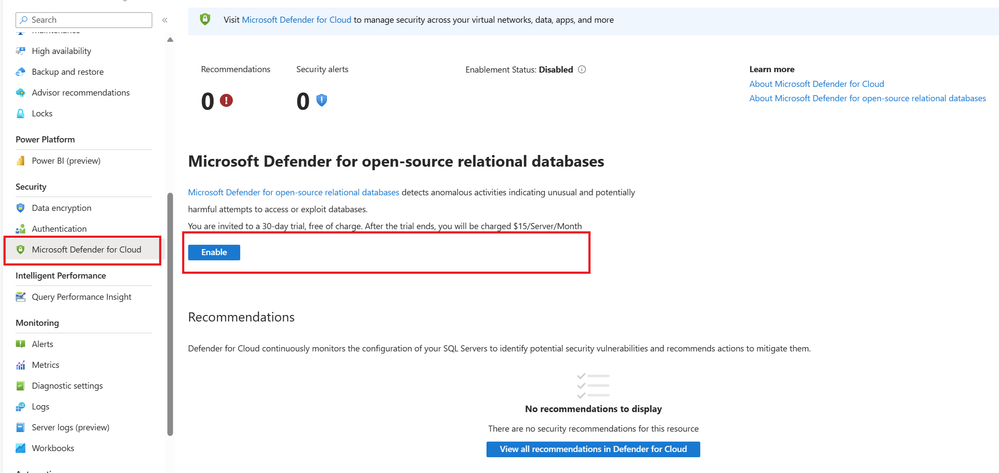 Enabling Defender with PostgreSQL Flexible Server in Azure Portal
Enabling Defender with PostgreSQL Flexible Server in Azure Portal
- From the Azure portal, navigate to Security menu in the left pane.
- Pick Microsoft Defender for Cloud
- Click Enable in the right pane.
Resources
For more information on Azure Defender and its use with Postgres Flexible Server see following:
To learn more about our Flexible Server managed service, see the Azure Database for PostgreSQL service page. We’re always eager to hear customer feedback, so please reach out to us at Ask Azure DB for PostgreSQL.
by Contributed | Dec 12, 2023 | Technology
This article is contributed. See the original author and article here.
Today, we’re excited to announce the public preview of the Arc VS Code Extension – a one-stop-shop for all your developer needs. Whether you’re just starting your journey with Arc, or you’re already in production with an Arc enabled application, our extension can help streamline your developer experience. The Arc VS Code extension is a home for Enterprise and ISV developers alike. The features built into the extension can help you accelerate development for both workloads that you’re running on the Edge, as well as services that you’re building to publish on the Azure Marketplace.
We understand that it can be time consuming to learn new technologies and develop and test your applications. To add to the challenge, building your first application will require you to ramp up and interact with multiple products as you go through the developer workflow. To simplify this experience, we’re bringing these resources to VS Code so you never have to leave your workbench. You can use the Azure Arc VS Code Extension to deploy your first Arc enabled environment, learn Arc technologies using sample applications, and deploy to an AKS cluster for testing.
A Developer Hub for Arc
By downloading the Arc Extension to your VS code, you can now complete the following tasks in-editor:
- Deploy your first Arc enabled environment by creating a single machine AKS cluster. You can use this cluster to deploy applications locally and test your Arc enabled workloads.
- Connect your AKS clusters in your development or test environments to Arc using a single click.
- Discover sample applications by using the VS Code Extension to clone the Jumpstart Agora repository, a collection of sample applications for various cloud-to-edge scenarios.
- Create your first Arc-enabled service from scratch, even a simple HelloWorld application, with the sample code provided by deploying it on an AKS cluster on your desktop. Once you’ve created your HelloWorld application, you can then begin to deploy more complex applications, including this sample application with KeyVault
What’s next for the Arc VS Code Extension
We’re currently in public preview, and we’re working hard to add more features to the VS Code Extension that will further simplify your developer workflow. We’re working on more sample applications and a more flexible and robust developer environment.
Feedback & Contributions
The Arc VS Code Extension is an open-source, MIT-licensed product! Our team is excited to collaborate with all of you and intends for the Arc VS Code Extension to be community-driven. We welcome contributions as well as feedback. Our team encourages you to file issues, open pull requests, contribute to discussions, and more via our GitHub repository.
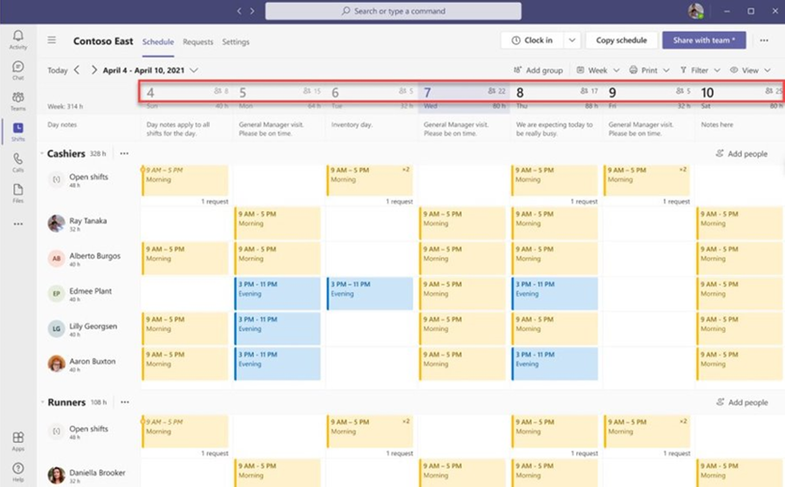
by Contributed | Dec 11, 2023 | Technology
This article is contributed. See the original author and article here.
Enhancing frontline manager productivity remains a critical priority for countless organizations and Microsoft. We are excited to introduce a range of new Shifts features to further empower our frontline heroes through seamless evolution that aligns perfectly with your ever-changing needs, all thanks to your invaluable feedback. Let’s unwrap some of the highlights.
1. People Count Display on Shifts Calendar
Frontline managers (FLM) can now make informed staffing decisions with the introduction of the people count displayed on the Shifts calendar. This feature provides a clear view of staffing levels, ensuring that the right workforce is scheduled for the day, week, or month. Managers can now see the scheduled people count at both the team, and schedule group levels.

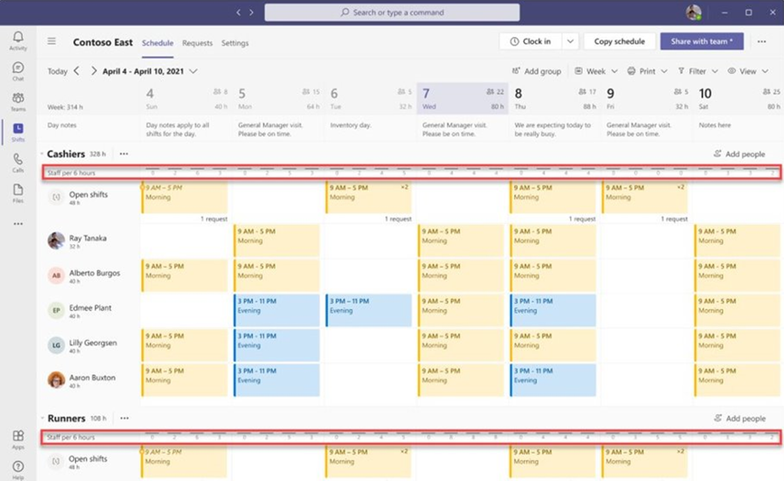
2. Core UX Improvements
We’ve streamlined the user experience with some core improvements:
1) Full Name Display: Team members’ full names are now visible in the team schedule. This helps managers quickly identify staff members by their full names, even when names are lengthy, by toggling profile pictures on/off.
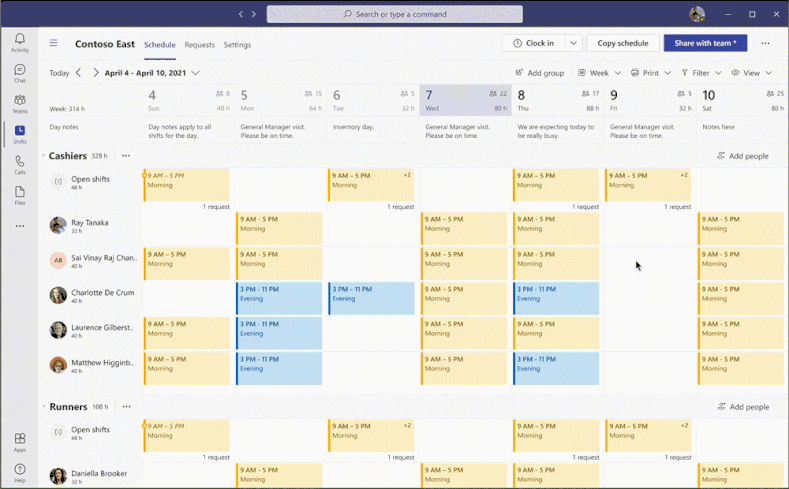
2) Saving Last Used Filter: We understand that frontline managers and workers use various filters to customize their Shifts view. Our latest feature automatically saves the last used filter, so when users relaunch the Shifts app, their preferred view from the last session is readily available.
3) Shifts notes in Day view: Day view shows the shift notes inline, which helps managers save time.
3. Manager-Controlled Settings
Frontline Managers now have additional controls on team-level settings that provide the ability to control all our Shifts marketplace and visibility capabilities.
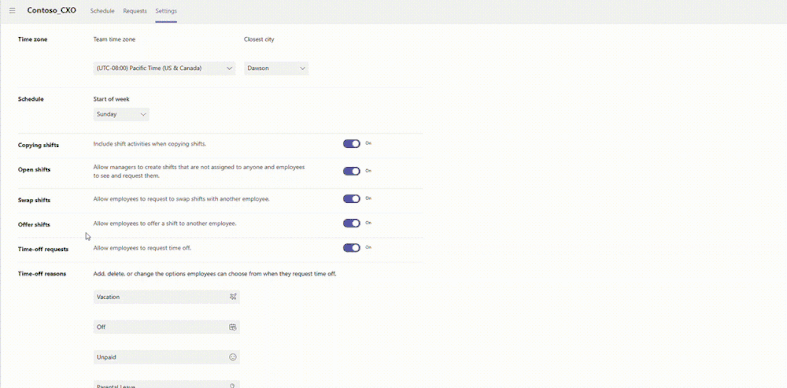
1) Visibility controls: Frontline managers can control shift information visibility for their Frontline Workers (FLW).
Limited Past Views: Managers can restrict how far back FLWs can view their coworkers’ schedules, ensuring historical data privacy.
When FLM configure the past schedule view up to certain months – FLWs cannot see other’s schedules beyond the configured duration.
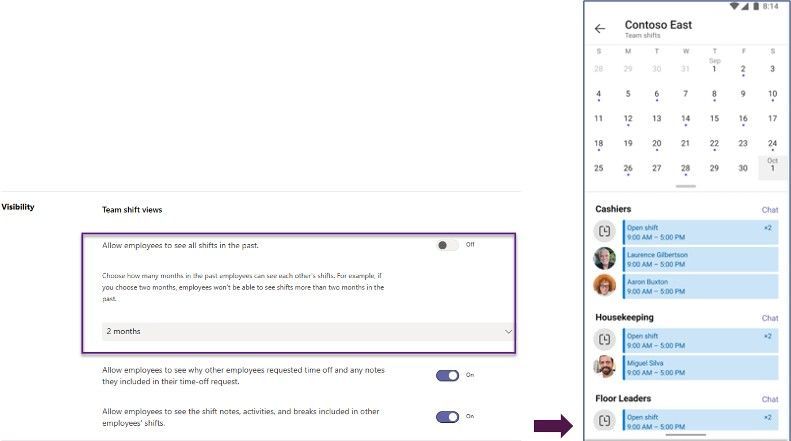
Generic Time Off View: FLWs can see their colleagues’ time off in a generic way, without access to specific reasons and notes.
When FLM’s disable the visibility of time off reason and notes – FLWs see a generic time off reason of other FLW’s.
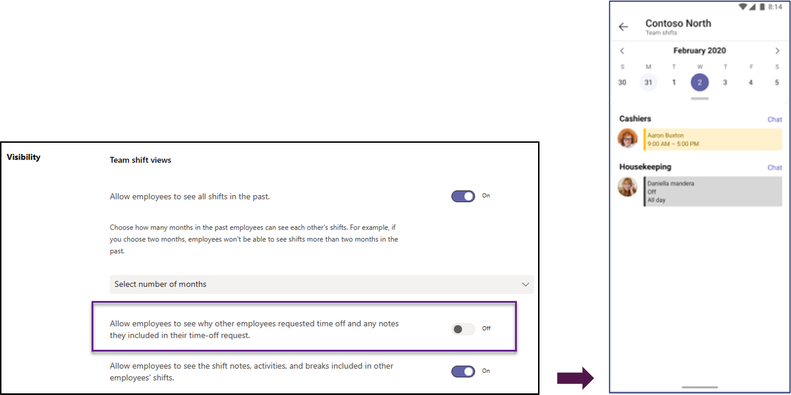
Limited Shift Details: Managers can limit the level of detail available to FLWs about their coworkers’ schedules, excluding sensitive information like Shift notes, Activities, and break duration.
When FLM’s disable the visibility of shift notes, activities, break duration – FLWs cannot see the shift details of other FLWs.
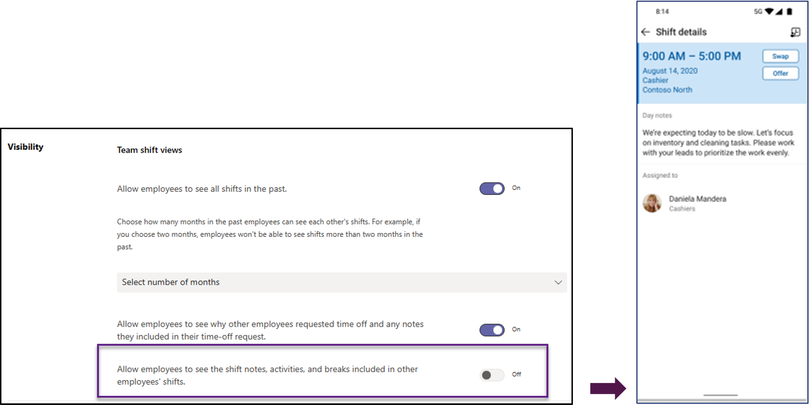
2) Shifts marketplace controls: Your organization can pace the journey towards frontline self-serve capabilities through your frontline managers ability to choose which capabilities should be offered to their workers. We have added the following new controls:
Swap shift requests: Frontline managers can decide if workers can create requests to swap their shifts with other coworkers. The requests require managers’ approval before becoming effective on the Shifts calendar.
Offer shift requests: Frontline managers can decide if workers can create requests to offer their shifts to another coworker. The requests require managers’ approval before becoming effective on the Shifts calendar.
Time off requests: Frontline managers can decide if workers can create requests for time off work. The requests require managers’ approval before becoming effective on the Shifts calendar.
4. Graph API for Day Notes
Now, managers have the flexibility to add day notes using the Graph API, in addition to the Shifts app. This powerful capability allows customers to seamlessly integrate relevant day notes from third-party, or line-of-business applications, enhancing the Shifts experience.
dayNote resource type – Microsoft Graph beta | Microsoft Learn
5. Import and export time offs and open shifts into Excel
Managers using Shifts web and desktop applications are now allowed to import not only assigned shifts, but also open shifts and time offs from Excel into Shifts. Additionally, these same schedule entities will be supported when managers export a schedule in a format compatible to the import.
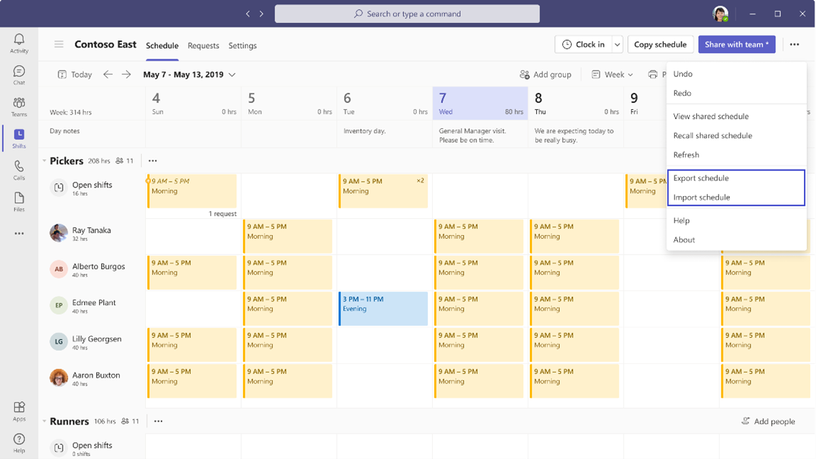
What’s coming next –
Setting Availability by date: Frontline workers can set their availability on specific dates in addition to their recurring availability.
These enhancements are a result of listening to your feedback, and we’re committed to continuing to improve Shifts to meet your evolving needs. We hope these new features empower your frontline teams and streamline your workforce management processes.
We value your input! Please take a moment to share your thoughts via this brief survey and include your email for any further queries. We’re eager to connect with you!
by Contributed | Dec 10, 2023 | Technology
This article is contributed. See the original author and article here.
Unlocking Value with the Power Platform
For years now, the Power Platform has been a low code tool that unlocks value across your business by accelerating application & automation development to meet business demand faster. Whether you’re a professional developer, an IT admin, business analyst, or a non-technical employee, low code empowers you to create solutions in a fast, secure, and compliant fashion. Now with the rise of AI, organizations are moving quickly to embrace AI in order to usher in a new wave of growth and value creation.
Introducing the Livestream Series: Let’s Learn Power: A Real-life AI + Power Platform Use Case
With that, I am excited to announce a 3-part livestream series which will be hosted on the Microsoft Reactor channel that focuses on bringing the Power Platform and AI together. The series is titled Let’s Learn Power: A Real-life AI + Power Platform Use Case and it explores the integration of the Power Platform with advanced AI models to create a dynamic application inspired by Kevin Scott’s Microsoft Build 2023 demo. This application makes it easy to generate a social media post promoting a new episode of your podcast. Starting from a podcast URL, we journey through speech-to-text transcription to generate a transcript of the podcast, given that transcript, we perform guest identification and guest bio retrieval, followed by social media post generation with image creation, and finally, posting to LinkedIn from Power Apps or Copilot Studio. All powered by Azure OpenAI Service and the Power Platform AND I will walk you through it all from start to finish.
As mentioned, there will be 3 episodes livestreamed on the following dates and times:
Episode 1: Laying the Foundation: Azure Open AI Service and Power Platform
Dive into the world of Azure OpenAI Service. We introduce the service, describe the models, and guide you through creating deployments. Setting the stage for seamless AI integration.
11 December 2023 | 9AM PST | 7PM SAST
Episode 2: Bridging the Gap: .NET APIs, Azure, and Custom Connectors
We take a step further from Episode 1 by creating a .NET API using the .NET Azure OpenAI SDK, creating Azure Resources with the Azure Developer CLI, deploying the API to Azure App Service and Azure API Management and Creating a Custom Connector from API Management.
12 December 2023 | 9AM PST | 7PM SAST
Episode 3: The Final Touch: Power Apps and Microsoft Copilot Studio Integration
The final episode brings it all together. We will build the Power App UI, connect to the Custom Connector, and publish the social media post to LinkedIn. As a bonus, we will also see how to implement this workflow with a Microsoft Copilot Studio custom copilot.
13 December 2023 | 9AM PST | 7PM SAST
You can register to watch all 3 livestreams here: Register Now! and can’t wait to see you there!

by Contributed | Dec 9, 2023 | Technology
This article is contributed. See the original author and article here.
Embark on a Holiday Coding Adventure with GitHub Copilot
Hello students! Are you looking for a fun and engaging way to learn new coding concepts and languages over the holiday season? If so, you might want to check out Microsoft Copilot Adventures, a series of coding challenges powered by GitHub Copilot, an AI pair programmer that assists you in writing better code.
In this article, we’ll show you how to start your adventure, choose from different levels of difficulty and topics, and use GitHub Copilot hints to help you write your code. You’ll also learn how to share your solution with others and get feedback.
Whether you’re a beginner or an expert, Microsoft Copilot Adventures will help you improve your coding skills and have fun at the same time. So, what are you waiting for? Start your adventure today!

Welcome to Coding Adventure with GitHub Copilot
We are going to introduce you to an exciting series of coding adventures that will help you learn new concepts and languages over you holiday vacation period. This adventure experience and activities is brought to you by none other than GitHub Copilot, an AI pair programmer that assists you in writing better code.
What is GitHub Copilot?
GitHub Copilot is a tool designed to assist you in writing code. It’s like having a pair programmer who’s always ready to help.Whether you’re a beginner just starting out or an experienced coder looking to learn a new language, GitHub Copilot can be a valuable companion on your coding journey
How to Start Your Adventure
To get started, you’ll need to enter the “adventure area”. This is done by creating a GitHub Codespace Don’t worry, you can use 60 hours of GitHub Codespaces for free each month and if your registered GitHub Student Education pack user you get FREE access to codespaces Alternatively, you can clone the repo and run it locally.
Choose Your Adventure
Once you’ve set up your environment, it’s time to choose your adventure. There are several adventures available, each designed to challenge your coding skills and help you learn new concepts
Beginner Adventures
Intermediate Adventures
Advanced Adventures
Start Coding
After choosing your adventure, you’ll be given a description, high-level tasks to perform, and GitHub Copilot hints to help you write your code. You can use any language you’d like.If you’re up for a challenge, try learning a new language.
Share Your Adventure
If you’d like to share your solution with others, you can publish your adventure solution to a GitHub repo. Then, visit the issues page and select ‘New Issue’. Use the following naming convention for the issue title: ‘Solution for [Name of Your Adventure]’. Replace ‘[Name of Your Adventure]’ with the adventure name you chose to solve .
Conclusion
Embarking on a Holiday coding adventure with GitHub Copilot is a fun and engaging way to learn new coding concepts and languages. So, what are you waiting for? Start your adventure today!
Happy coding!
PostgreSQL brute force attack example
Enabling Defender with PostgreSQL Flexible Server in Azure Portal


Recent Comments